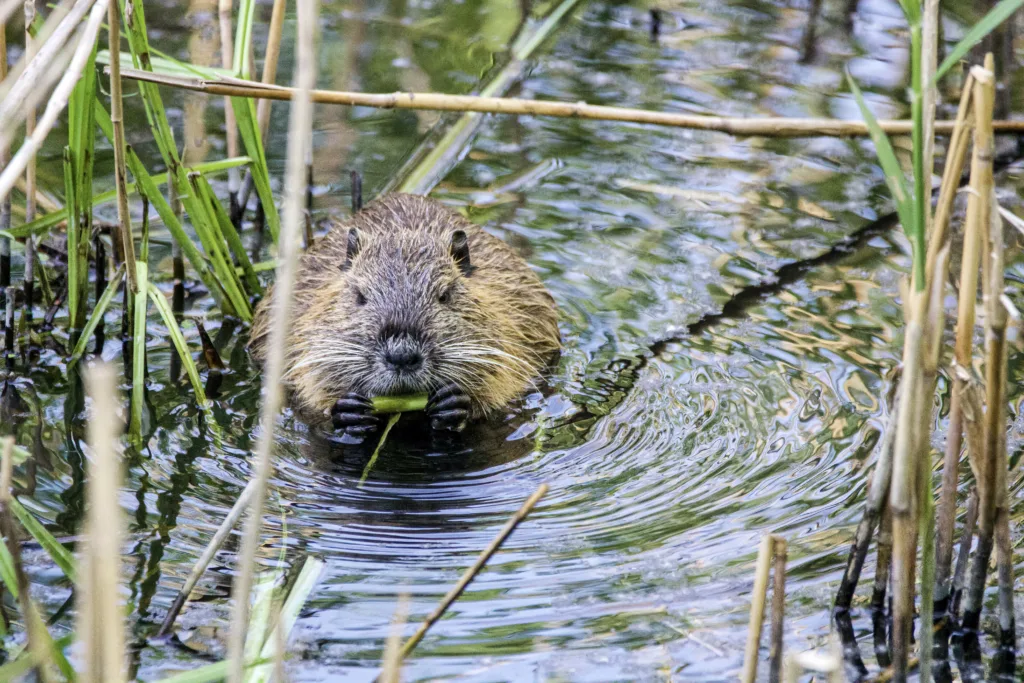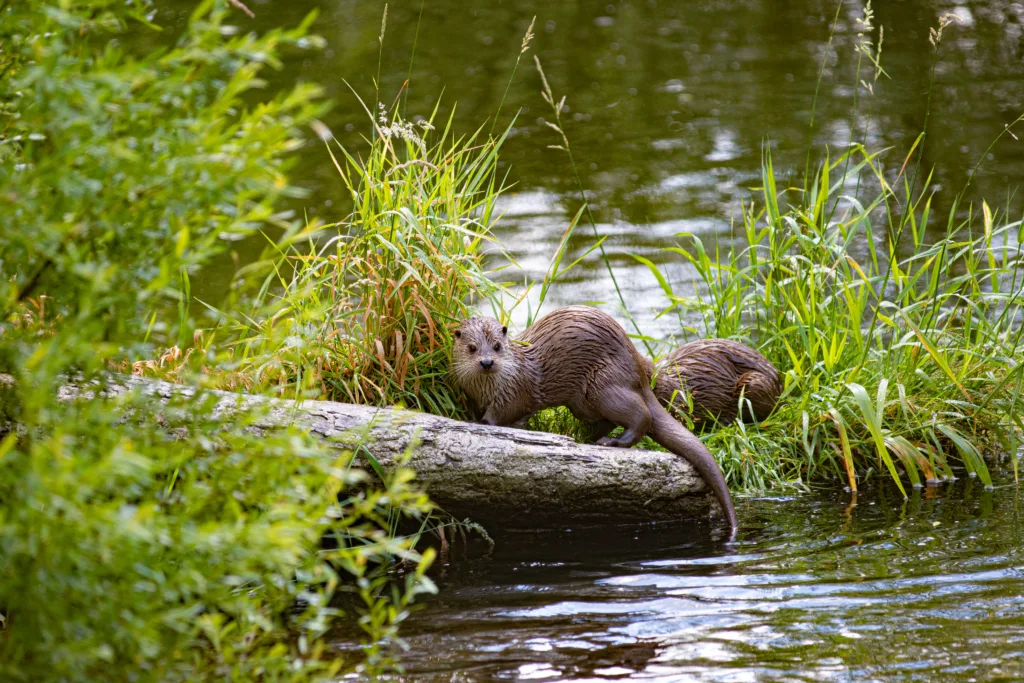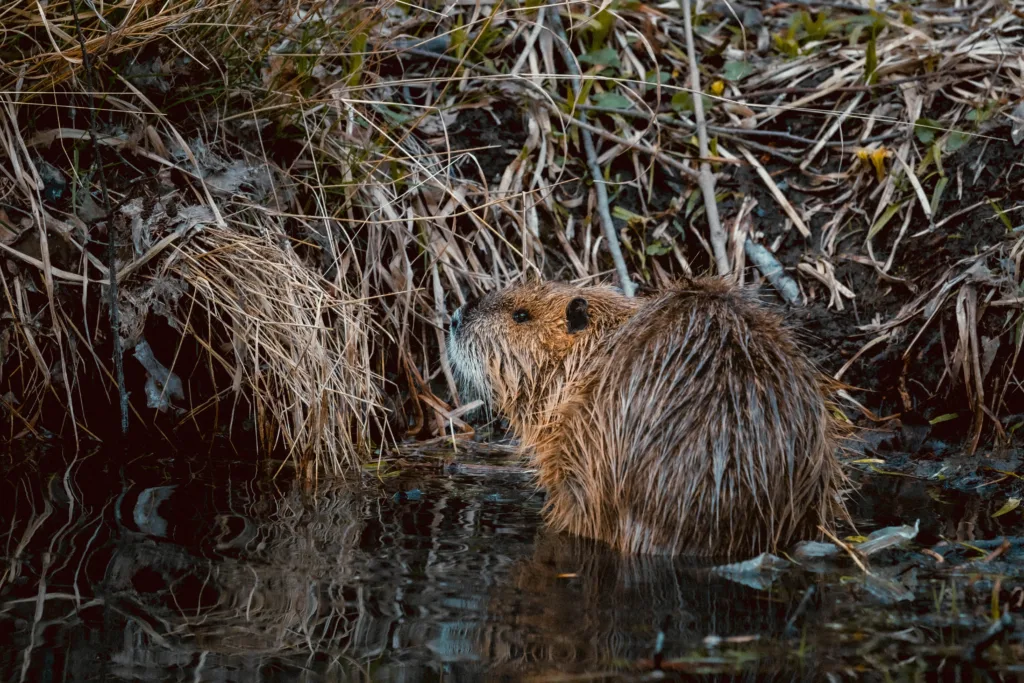Beavers are fascinating creatures that are known for their impressive ability to construct complex dams and lodges. These structures serve as their homes and help them survive in their natural habitat. While they are primarily herbivores and rely on vegetation for their diet, many people wonder if they also consume fish.
The answer is no. Beavers are not known to eat fish as they are strictly herbivores. Their diet mainly consists of the bark, leaves, and twigs of trees, along with aquatic plants like lilies, pondweed, and cattails. They also consume shrubs and fruits like apples, but fish are not a part of their diet.
Beavers are known for their sharp incisors that are perfect for cutting through tree bark, which is their primary source of food. They use their strong jaws to chew on the wood and extract the nutrients they need. Their teeth are continuously growing, and they need to gnaw on wood regularly to keep them in check.
Beavers are crucial to the ecosystem as their dams and lodges create wetlands that serve as habitats for many other species. Their ponds store cool water in the summer, which is beneficial for cold-water-loving fish like trout and salmon. In fact, beaver ponds have been known to provide habitat for endangered species like steelhead and spring Chinook.
While beavers do not eat fish, they are still a vital part of the food chain. Predators like coyotes, foxes, bobcats, otters, and great-horned owls prey on beavers for their meat, fur, and other resources. However, beavers are not defenseless and will fight back if they feel threatened.
Beavers do not eat fish, and they are strictly herbivores. Their diet consists of tree bark, leaves, twigs, shrubs, and aquatic plants. While they may not consume fish, they play a crucial role in the ecosystem by creating wetlands that serve as habitats for many other species. Beavers are fascinating creatures that deserve our respect and protection.
The Benefits of Beavers for Fish
Beavers play a critical role in creating and maintaining aquatic habitats that benefit a multitude of fish species. By building dams, they create ponds and slow-moving streams that prvide shelter, food, and breeding grounds for fish. These ponds help to regulate water temperatures, which is especially important for cold-water-loving fish species like trout and salmon. The cool water stored in beaver ponds during summer months creates an ideal habitat for native fish species, such as endangered steelhead and spring Chinook. Additionally, beaver ponds help to filter pollutants and sediment from the water, which creates a healthier environment for fish to thrive in. In summary, beavers contribute significantly to the wellbeing of fish populations by creating and maintaining habitats that support the development and survival of various species.

What Do Beavers Eat?
Beavers are herbivores, which means that they feed on plants. Their diet mainly consists of the bark and twigs of trees such as aspen, willow, birch, maple, and alder. They also eat leaves, buds, and shoots of different plant species that grow near their habitat. During the summer months, beavers feed on aquatic plants such as water lilies, duckweed, and cattails. They store food in their lodges or dams to survive the winter months when food is scarce. Additionally, beavers have a unique digestive system that allows them to extract as much nutrition as possible from their food, even tough plant materials like bark. Overall, the beaver’s diet is well-adapted to its habitat and plays an essential role in its ecosystem.
What Do Beavers Consume Most?
Beavers are herbivorous animals that mainly feed on the inner bark of trees. They also consume the bark and leaves of various trees, shrubs, twigs, and fruits such as apples. Since beavers spend most of their time in the water, they also eat aquatic plants like pondweed, lilies, and cattails. However, it’s important to note that beavers have a unique digestive system that allows them to extract nutrients from tough plant materials, which is why they rely heavily on tree bark as a primary food source. Overall, the inner bark of trees is the most significant part of a beaver’s diet.
Do Beavers Consume Meat?
Beavers are primarily herbivores that consume plant matter as their main source of food. They are known to feed on a variety of vegetation including twigs, foliage, bark, and aquatic plants. Although beavers are not known to be meat-eaters, there have been some rare instances where they have been observed feeding on small fish or insects. However, these instances are uncommon and do not make up a significant part of their diet. In general, the diet of beavers is mostly composed of plant matter, which they are well adapted to digest using their specialized digestive system.
The Benefits of Having Beavers in a Pond
Yes, having beavers in your pond can be beneficial for the ecosystem. Beavers create dams that create ponds, which provide habitats for a variety of species, including game animals like wood ducks, mink, and otter. These ponds also support vulnerable fish species like rainbow smelt, steelhead, and salmon. Additionally, beaver dams protect downstream spawning areas from sedimentation and create cool, deep pools that increase salmon and trout populations. However, beavers can also cause flooding and damage to property, so it is important to manage their populations appropriately.

Do Beavers Eat Fish in Ponds?
No, beavers do not eat fish in ponds. Beavers are strictly herbivores, which means they only feed on plant material. Their diet typically consists of a variety of woody, herbaceous, and aquatic plants. While beavers may construct dams in ponds to create suitable habitat for themselves, they do not prey on fish or any other aquatic animals. Instead, they rely on a diverse range of plant species to meet their nutritional needs.
Predators of Beavers
The beaver’s main predator, besides humans, is the wolf. The wolf is known to actively hunt and prey on beavers. However, other predators also pose a threat to beavers, including coyotes, wolverines, bears, foxes, and lynxes. These predators may attack beavers for their meat, but also for their fur, which is valuable in the fur trade. Despite these threats, beavers are actively managed throughout most of their range to ensure their survival and prevent over-predation.
Are Beavers Aggressive?
Yes, beavers can be aggressive in certain situations. They are known to defend their territory against perceived threats, including humans, other animals, and even other beavers. When beavers feel threatened, they may slap their tails on the water or charge at the perceived threat, using their sharp teeth and powerful jaws to defend themselves. While beavers can be territorial and aggressive, they generally prefer to avoid conflict and will only become aggressive if they feel their safety or the safety of their family is at risk.
Do Beavers Eat Fish?
No, beavers do not eat small fish. Although they are known to live in aquatic environments, they are completely herbivorous, meaning that they feed on vegetation such as aquatic plants, grasses, herbs and shrubs. In fact, beavers play a crucial role in maintaining the health of wetland ecosystems by creating dams and lodges that create habitat for a variety of plant and animal species. While they may occasionally consume small insects or snails, fish are not a part of their diet. Therefore, if you are looking to observe beavers in their natural habitat, you should focus on looking for areas with lush vegetation raher than fish.

The Lifespan of a Beaver
The lifespan of a beaver is about 16 years. Beavers reach maturity in 2-3 years, and female beavers become sexually mature at 2.5 years old. They give birth to one litter of kits per year, usually between April and July. It’s interesting to note that beavers are known for their ability to construct dams and lodges, which provide shelter and protection for their families. Despite being hunted for their fur and the destruction of their habitats, beavers continue to thrive in many parts of the world.
The Best Bait for Attracting Beavers
When it comes to trapping beavers, the best bait to use is their own castor. This is an odorous substance secreted by beavers as a way of marking their territory and communicating their presence to other beavers. As a result, beavers are naturally attracted to the scent of their own castor. Another effective bait for beavers is tree branches, particularly those of the poplar genera such as aspen and cottonwood. Beavers are known to feed on the bark and twigs of these trees, so usig branches as bait can be a great way to lure them into a trap. It’s important to note, however, that in some regions it may be illegal to use beaver castor as bait, so it’s always a good idea to check local regulations before attempting to trap these animals.
Beavers and Fear: What Are They Afraid Of?
Beavers are generally afraid of predators that pose a threat to them. These predators include coyotes, wolves, bears, and cougars. The smell of predator urine can soetimes deter beavers from an area. However, it is important to note that beavers are intelligent animals and can quickly learn to recognize and ignore fake predator scents. Additionally, beavers have a strong sense of smell and are sensitive to strong odors, such as ammonia or garlic. These scents can also be used as a deterrent, but they may not be effective in the long term as beavers can become accustomed to them. Overall, the most effective way to deter beavers is to physically block their access to an area or modify the habitat to make it less attractive to them.
The Friendliness of Beavers
Beavers are known for their industrious nature and their ability to create dams and lodges. However, when it comes to their demeanor towards humans, the answer to the question of whether beavers are friendly animals is somewhat complicated.
Beavers are generally not aggressive towards humans, but they also do not seek out human interaction. In fact, they are primarily nocturnal animals and tend to avoid humans altogether. Beavers are more likely to retreat into the water or their lodges when they sense human presence.
That being said, beavers are fiercely protective of their territory and can beome defensive if they feel threatened. If you happen to come across a beaver in the wild, it is important to keep a safe distance and avoid disturbing their habitat.
Overall, while beavers are not typically considered friendly animals, they are not necessarily hostile either. As with any wild animal, it is important to treat them with respect and caution to ensure both your safety and the well-being of the beavers.

The Safety of Eating Beaver
Yes, it is generally safe to eat beaver meat as long as it is properly prepared and cooked. Beaver meat is a lean source of protein and is also rich in nutrients such as iron and vitamin A. However, it is important to note that beavers are known to carry a parasite called giardia, whih can cause digestive issues in humans if ingested. Therefore, it is recommended to cook beaver meat thoroughly to kill any potential parasites or bacteria. It is also important to ensure that the beaver meat is sourced from a reputable and legal supplier, as hunting and trapping regulations vary by region.
Are Beavers an Aggressive Species?
Beavers are not necessarily angry animals, but they can become aggressive when defending ther territory against other animals or humans. They are known to be very territorial and will fiercely defend their dams and lodges against intruders. When confronted with a potential threat, beavers may slap their tails on the water to warn others and even charge at the intruder.
It is important to note that beavers are not naturally aggressive towards humans and will usually avoid contact if possible. However, if a beaver is infected with rabies, it may become disoriented and exhibit aggressive behavior towards humans. This is a rare occurrence, as beavers are not commonly infected with rabies.
In conclusion, while beavers are not generally angry animals, they can display aggression when defending their territory or when infected with rabies. It is important to respect their space and avoid disturbing their homes to prevent any potential conflicts.
Conclusion
In conclusion, it is clear that beavers are primarily herbivores, with a diet that consists manly of vegetation such as twigs, foliage, bark, and aquatic plants. While they do not typically eat fish, their presence in an ecosystem can have a positive impact on fish populations. Beaver dams create habitat for cold-water-loving fish species like trout and salmon, and beaver ponds store cool water in the summer, providing important habitat for endangered fish species like steelhead and spring Chinook. So while beavers may not eat fish themselves, they play an important role in supporting aquatic ecosystems and the species that depend on them.
